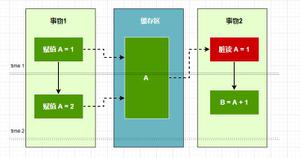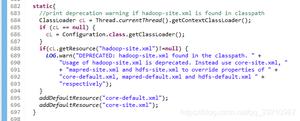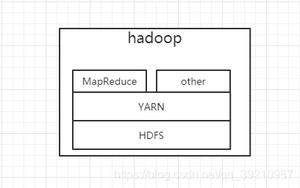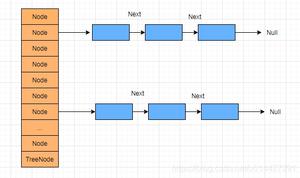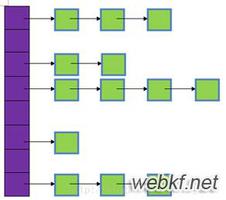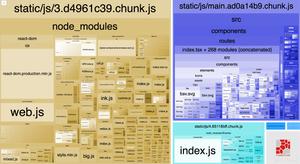WeakHashMap源码分析

WeakHashMap与HashMap有些类似,但也有很多地方不同。它们设置了相同的负载因子和初始容量,但是前者的数据结构只使用了数组+链表,并没有用到红黑树,
在这里,与HashMap重复且设置值一致的变量就不重复介绍了,只简单说下不同的地方。
代表空Key
privatestaticfinal Object NULL_KEY = new Object();复制代码
保存GC后被清除的WeakEntries
privatefinal ReferenceQueue<Object> queue = new ReferenceQueue<>();复制代码
Entry: 数组存放节点
privatestaticclassEntry<K,V> extendsWeakReference<Object> implementsMap.Entry<K,V> { V value;
finalint hash;
Entry<K,V> next;
Entry(Object key, V value, ReferenceQueue<Object> queue, int hash, Entry<K,V> next) { super(key, queue); this.value = value; this.hash = hash; this.next = next; } 复制代码
我们可以发现Entry继承了WeakReference,在其构造函数中,会创建一个新的弱引用指向给定的key。
WeakHashMap构造函数
publicWeakHashMap(int initialCapacity, float loadFactor){// 部分代码删除
int capacity = 1;
while (capacity < initialCapacity)
capacity <<= 1;
table = newTable(capacity); this.loadFactor = loadFactor; threshold = (int)(capacity * loadFactor); } 复制代码
在构造函数中,它会将数组容量大小设置为输入值的最接近的2的n次方;并调用newTable初始化数组。
接下来来分析几个重要的方法。
Put()方法
public V put(K key, V value){// 当Key为null时会返回一个名字为NULL_KEY的Object对象,表明Key支持Null
Object k = maskNull(key);
int h = hash(k);
// 将过期的Entry删除掉
Entry<K,V>[] tab = getTable(); // 获取桶的位置int i = indexFor(h, tab.length); for (Entry<K,V> e = tab[i]; e != null; e = e.next) { if (h == e.hash && eq(k, e.get())) { V oldValue = e.value; if (value != oldValue) e.value = value; return oldValue; } } modCount++; // 头插法插入节点 Entry<K,V> e = tab[i]; tab[i] = new Entry<>(k, value, queue, h, e); // 插入后大于等于阈值,进行扩容if (++size >= threshold) resize(tab.length * 2); returnnull; } 复制代码
expungeStaleEntries()方法
在调用get()、replaceAll()、containsNullValue()、forEach()、removeMapping()、remove()、resize()、put()等方式时再获取table数组时,不是直接返回table数组,而是通过getTable方法先把数组中key为null的Entry删除掉,再返回。
private Entry<K,V>[] getTable() { expungeStaleEntries();
return table;
}
复制代码
privatevoidexpungeStaleEntries(){// 从ReferenceQueue中取出过期的节点
for (Object x; (x = queue.poll()) != null; ) {
// 锁住ReferenceQueue
synchronized (queue) {
@SuppressWarnings("unchecked") Entry<K,V> e = (Entry<K,V>) x; // 为了方面,插入indexFor的代码/** * private static int indexFor(int h, int length) { return h & (length-1); } **/int i = indexFor(e.hash, table.length); Entry<K,V> prev = table[i]; Entry<K,V> p = prev; while (p != null) { Entry<K,V> next = p.next; if (p == e) { // 如果数组头节点过期了if (prev == e) table[i] = next; // 将前驱节点的next指向它的下一个节点,即把该节点从链表中去除else prev.next = next; // 将该节点的value设置为null,帮助gc e.value = null; // Help GC size--; break; } prev = p; p = next; } } } } 复制代码
Resize()扩容
在扩容前,先删除过期的Entry,然后新建一个容量是原来2倍的数组;之后调用transfer方法进行扩容。如果扩容后size大小大于等于阈值的一半,则更新阈值;如果小于阈值的一半,则再调用一次expungeStaleEntries方法,再从新表转化到原来的旧表中。
voidresize(int newCapacity){// 在扩容前先删除过期的Entry
Entry<K,V>[] oldTable = getTable();
int oldCapacity = oldTable.length;
if (oldCapacity == MAXIMUM_CAPACITY) {
threshold = Integer.MAX_VALUE; return; } // 扩容为原来的2倍 Entry<K,V>[] newTable = newTable(newCapacity); transfer(oldTable, newTable); table = newTable; // 如果忽略null元素并处理ref队列导致大量收缩,则还原旧表// 这应该很少见,但是可以避免垃圾填表的无限扩展。if (size >= threshold / 2) { threshold = (int)(newCapacity * loadFactor); } else { expungeStaleEntries(); transfer(newTable, oldTable); table = oldTable; } } 复制代码
transfer()方法
遍历旧数组,如果key为null,则设置其Entry的next和value都为null,帮助gc;如果不为null,则计算该Entry在新数组中的位置,利用头插法进行插入。
privatevoidtransfer(Entry<K,V>[] src, Entry<K,V>[] dest){for (int j = 0; j < src.length; ++j) {
Entry<K,V> e = src[j];
src[j] = null;
while (e != null) {
Entry<K,V> next = e.next; Object key = e.get(); if (key == null) { e.next = null; // Help GC e.value = null; // " " size--; } else { int i = indexFor(e.hash, dest.length); e.next = dest[i]; dest[i] = e; } e = next; } } }
以上是 WeakHashMap源码分析 的全部内容, 来源链接: utcz.com/z/518237.html

